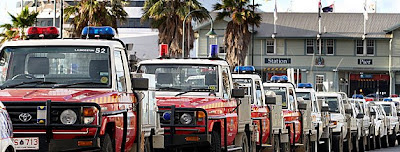The bush fires are still burning in southeast Australia and it could be a long time before an accurate death toll is compiled. It may be weeks before the surviving residents of Marysville are allowed to return to their devastated community where it is feared that up to 100 of the 519 inhabitants perished in the fire.
When I read accounts like the one below from a Country Fire Authority firefighter, I am left stunned. From The Australian:
CFA firefighter John Munday, who was in one of the fire trucks that entered Marysville about 10 minutes before the firefront swept through the town just before 6pm on Saturday, described in horrific detail how little hope so many residents had of escaping, let alone surviving.Tasmania, a very large island off the southeast coast of Australia, sent 90 firefighters and 29 fire trucks across the sea to help their mainland brothers and sisters.
"The toll is going to be massive," Mr Munday said.
He described how he and his crew had to make the heartbreaking decision to save themselves knowing they were leaving people to die.
"We had people banging on the sides of our tanker begging us to go back to houses where they knew there were people trapped, but we couldn't because if we had, we'd all be dead too," Mr Munday told The Australian.
"There were children running down the streets with flames behind them. It was hell. I never want to go back to that place, never.
"As we drove down to the Gallipoli Park, where people were assembling, we knew there were people in homes that were on fire and they had no hope.
"The whole town died around us as we bunkered down on the outside of the oval ringed by funeral pyres while all around us we had the screaming noise of gas cylinders exploding in homes.
"The only way we could have saved them was to put ourselves on the altar and put a sword to our own hearts."
The official death toll from the Black Saturday fires had risen to 181 last night, with 15 confirmed dead in Marysville.
Late last night an urgent threat was declared for townships surrounding the Alexandra base camp from which fire fighting efforts were being coordinated after a southerly change fanned the Murrindindi/Yea fire which covers more than 100,000 hectares.
 Tasmania Fire Service trucks are lined up ready to be deployed to fight the Victorian bushfires. Photo: Brad Marsellos
Tasmania Fire Service trucks are lined up ready to be deployed to fight the Victorian bushfires. Photo: Brad MarsellosThe United States may send some overhead-types to assist with the fires. The National Interagency Coordination Center sent out a letter asking for preliminary lists of available Incident Commanders, Fire Behavior Analysts, Operations Section Chiefs, and air operations folks. (ed.: they are also seeking Division-Group Supervisors, Task Force Leaders, and Information Officers.)
The "Prepare, Stay and Defend OR Go Early" program, used extensively and successfully in Australia for years, is already a topic of discussion. But this was no ordinary fire situation (if there is such a thing).
A "down under" fire chief friend of mine sent me some of his thoughts and observations last night:
Don't forget that while the weather was forecast and the possibility of fires foreseen, the severity of the weather and the rate of spread and intensity of the fires was not. Even if there had been a mandatory evacuation culture in place in Aus I guarantee that it could not have been implemented in the time available, and given the narrow and winding roads in a lot of the area burnt mandatory evacuation quite probably would have increased the number of fatalities.My thoughts are with the families of the victims, and the firefighters still working their butts off.
Don't forget that these fires really kicked on AFTER the wind changed very rapidly from NW to SW, turning the NE flank of several fires into the headfire. In ridge and gully country the fronts would have broken up into tongues so that people fleeing a fire they could see might often find that they had been outflanked and cut off by tongues before they even realised they were in danger.
I suspect that the photos I have seen of cars which have crashed into fallen trees are the result of this situation, people trying to drive through fire and smoke, probably at some speed and hitting a tree already felled by the fire. Not many options or much hope at that point.
Finally, remember 2 things. People are safer in their house than fleeing in a car, and marginally safer in the car than running ahead of a fire on foot.
More information:
The Australian
ABC.net.au
ninemsn.com.au





No comments:
Post a Comment